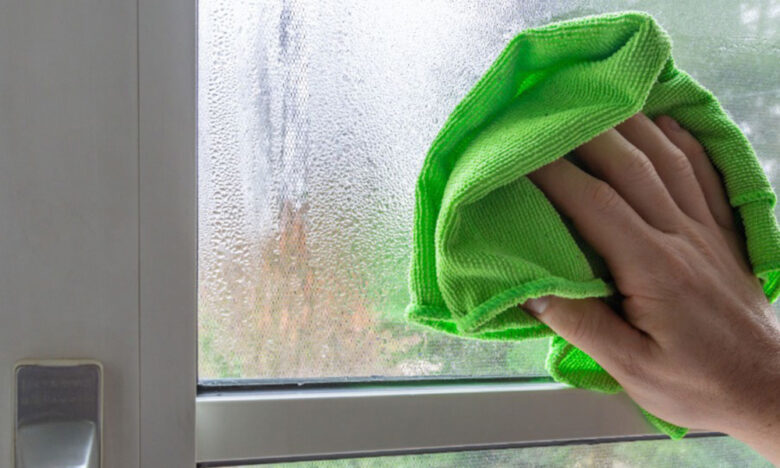
Controlling Condensation and Mould
Pretty much every home will show signs of condensation at some point. This could come in the form of droplets of water on a window on a cold morning, excess moisture in the air when hot water hits a cold bath, or from cooking on a hob without ventilation. Often condensation is nothing to worry about, but if you’re buying a property, it should be investigated thoroughly to ensure it’s not a sign of a bigger problem.
What are condensation and mould?
Condensation, a common damp, occurs when warm, moist air comes into contact with cooler air or surface. It is often more of a problem in rooms containing a lot of moisture, such as kitchens and bathrooms, or in spaces with poor ventilation.
The first signs to look out for include excess water collecting on windows and mirrors; you may even see moisture drops on walls. While this happens in most homes occasionally, it may be considered an air ventilation issue if it occurs consistently and regularly. It’s also the case that the effects of condensation can worsen over time, producing mould. Pinpoint black spots are a tell-tale sign of mould, usually on the inside surfaces of external walls, corners and areas that lack ventilation, such as behind cupboards and wardrobes.
What problems can be caused by condensation and mould?
Often condensation and mould are more of an inconvenience than a serious issue but left untreated; they can cause several problems. For example, regular condensation around windows can lead to decaying window frames as well as stains and wet corners. It can also cause wallpaper to peel and lead to damp, musty smells throughout a property. In more serious cases, mould can start to build up not just on walls but also on curtains, carpets, soft furnishings, tiles and window sills. It can also grow unseen in areas such as behind wall linings and external cladding.
As well as being unpleasant to look at, this mould can have longer-term implications for the health of occupants and the integrity of the property. According to the NHS, if you have damp and mould in your home, you’re more likely to have respiratory problems, infections, allergies or asthma. Damp and mould can also affect the immune system.
If moisture becomes trapped within the structure of a property, it can lead to the corrosion of external walls and metal structures, timber rot, loosening of nails as timber swells, and cladding rot or swelling, all of which can result in costly rectification work.
In these times of high energy prices and greater environmental awareness, it’s also worth noting that condensation can negatively impact a home’s energy efficiency due to moisture saturation of the insulation.
How to combat condensation and mould
Treating and managing condensation build-up as much as possible is important with these potentially costly and unpleasant outcomes. The good news is that if you do this as soon as you see the first signs of condensation, there are relatively simple and cheap ways to stop it from developing into a more significant issue. Quite often, it’ll be areas of the home that are high in moisture, such as the kitchen and bathroom, where you’ll first notice any condensation. Top tips here include:
- Keeping doors to these rooms closed so that moisture doesn’t spread.
- Covering pans with lids when cooking to reduce the amount of steam released.
- Using an extractor fan when cooking on the hob and opening windows where possible to ensure some ventilation level.
- Avoid drying clothes indoors, particularly on radiators, as this can release a large amount of moisture into the air.
Good air circulation is key to reducing condensation so try to leave space between the walls and furniture to minimise the number of nooks and crannies where condensation and mould could lurk. Also, don’t overfill wardrobes and cupboards, as this can impact ventilation levels and create the opportunity for mould to thrive.
Alongside ventilation, temperature plays a crucial role in keeping condensation levels low. Keeping the property at a temperature that means surfaces aren’t cold will reduce the likelihood of condensation. Installing double glazing, loft insulation, and draft-proofing will help reduce the amount of heat lost from a property, keeping internal temperatures higher.
If you do spot any condensation, be sure to dry it thoroughly and then wring the cloth dry. Each morning, checking common problem areas, such as around windows and cold surfaces, is a good habit to get into.
If the condensation has already taken hold and there are signs of mould building, you may need to use more elbow grease to get rid of it and keep it at bay in the longer term. Cleaning spores off with soapy water would be a sensible first step. But if stains are more stubborn, try carefully spraying the area with a diluted bleach mix, leave it to dry overnight and then follow with an anti-fungal wash. Once that has dried, you could opt for mould-resistant paint to reduce the chances of reoccurring.
The Novello Approach
Despite condensation and mould being relatively common, traditional building surveys often overlook them. With Novello’s Private Client Surveying service, you’ll receive standard information on dampness, condensation and timber defects. Our RICS-qualified surveyors will undertake a thorough dampness inspection using electronic moisture meters to highlight any issues, including those that may not be visible to the naked eye. They will then advise on the likely causes and, if necessary, recommend further investigations from a damp specialist. We’ll even share our trusted contacts so you can be sure any further investigations will get to the root of the problem so you can proceed confidently.
This is just one element of our bespoke Private Client Surveying offering that ensures any areas of concern are thoroughly investigated, the result clearly explained and the next steps advised so you can make the right decisions even if issues are discovered during the survey.
To find out more about Private Client Surveying and the many benefits it offers, including floor area measurements, building insurance cost assessment, an optional reflective market valuation add-on, help obtaining quotations or arranging any further investigations, and advise on a negotiation strategy if needed, contact us today or book a free consultation.

